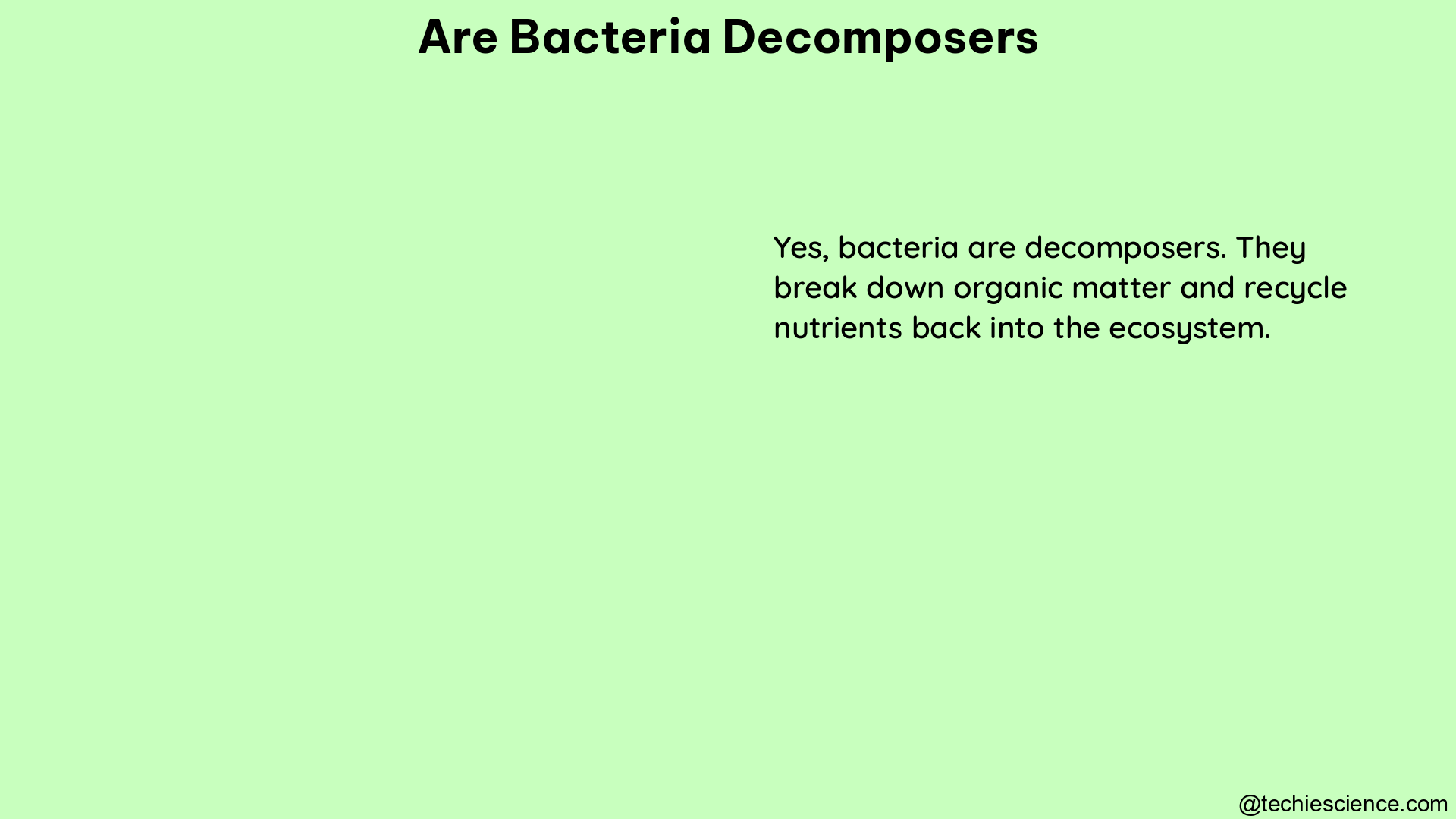Bacteria are essential decomposers that play a vital role in breaking down organic matter and recycling nutrients in various ecosystems. By understanding the measurable data and specific details about bacteria as decomposers, we can gain valuable insights into their ecological significance and contribution to nutrient cycling.
The Crucial Role of Bacteria in Decomposition
Bacteria are a diverse group of microscopic organisms that are ubiquitous in the environment. They are known for their ability to break down a wide range of organic compounds, including cellulose, lignin, and other complex molecules. This ability makes them crucial players in the decomposition process, where they break down dead plant and animal matter, releasing the stored nutrients back into the environment.
Measuring Bacterial Decomposition Activity
Researchers have developed several methods to quantify the activity and contribution of bacteria in the decomposition process. These include:
-
Direct Counts: This method involves directly counting the number of bacteria present in a sample using microscopy or flow cytometry techniques. This provides a direct measure of the bacterial population size.
-
Biomass Measurements: By determining the total amount of bacterial tissue or biomass in a sample, researchers can estimate the overall contribution of bacteria to the decomposition process.
-
Respiration Rates: Measuring the amount of carbon dioxide (CO2) produced by bacteria during decomposition can provide insights into their activity levels and the rate of organic matter breakdown.
Thermal Adaptation of Decomposer Communities
A study on the thermal adaptation of decomposer communities in warming soils found that measurable physiological adjustments of the soil microbial biomass reflect shifts from colder- to warmer-adapted taxa. This suggests that as the climate changes, the composition of decomposer communities may also shift, potentially impacting the overall rate of decomposition and nutrient cycling.
| Measurement | Findings |
|---|---|
| Soil Microbial Biomass | Showed physiological adjustments reflecting shifts from colder- to warmer-adapted taxa |
| Hypothetical Declines in Microbial Biomass Growth | Attributed to changes in the composition of decomposer communities under warming conditions |
These findings highlight the importance of understanding how decomposer communities, including bacteria, respond to environmental changes, such as temperature fluctuations.
Bacterial Succession in Leaf Litter Decomposition
Another study on bacterial succession on decomposing leaf litter revealed that bacteria associated with dead fungal mycelium were particularly important during the initial stages of decomposition. These bacteria accounted for up to 40% of the total bacterial community, suggesting their significant role in the early breakdown of leaf litter.
This study underscores the dynamic nature of the decomposition process, where different microbial communities, including bacteria, play specific roles at different stages of organic matter breakdown.
Bacteria’s Contribution to Soil Organic Matter Decomposition
A comprehensive review on the role of bacteria in soil organic matter decomposition found that bacteria are responsible for breaking down a substantial portion of soil organic matter, particularly in soils with low fungal-to-bacterial ratios. The review also highlighted the importance of bacterial growth yield efficiencies in regulating soil organic matter decomposition rates.
This information emphasizes the critical contribution of bacteria to the overall decomposition of organic matter in soil ecosystems, and the need to consider their specific roles and activities in understanding nutrient cycling processes.
Conclusion

Bacteria are essential decomposers that play a crucial role in breaking down organic matter and recycling nutrients in various ecosystems. By understanding the measurable data and specific details about bacteria as decomposers, we can gain valuable insights into their ecological significance and contribution to nutrient cycling. The studies discussed in this article provide a comprehensive overview of the methods used to quantify bacterial decomposition activity, as well as the insights gained from these measurements. This knowledge can inform our understanding of how decomposer communities, including bacteria, respond to environmental changes and contribute to the overall functioning of ecosystems.
References:
- Thiessen, S., Gleixner, G., Wutzler, T., & Blume, T. (2013). Importance of soil organic matter stability for soil water retention properties. Geoderma, 202-203, 137-147.
- Frossard, A., Gerull, L., Mutz, M., & Gessner, M. O. (2012). Disconnect between decomposer community structure and litter mass loss in an alpine stream. Ecology, 93(10), 2251-2260.
- Thiet, R. K., Frey, S. D., & Six, J. (2006). Do growth yield efficiencies differ between soil microbial communities differing in fungal:bacterial ratios? Reality check and methodological issues. Soil Biology and Biochemistry, 38(4), 837-844.
- Decomposer Communities – an overview | ScienceDirect Topics: https://www.sciencedirect.com/topics/agricultural-and-biological-sciences/decomposer-communities
- Culturing Bacteria and Fungi Decomposers – Cary Institute of Ecosystem Studies: https://www.caryinstitute.org/news-insights/podcast/culturing-bacteria-and-fungi-decomposers
- Dirty Decomposers – Lesson – TeachEngineering: https://www.teachengineering.org/lessons/view/cub_decomposition_lesson01
I am Ankita Chattopadhyay from Kharagpur. I have completed my B. Tech in Biotechnology from Amity University Kolkata. I am a Subject Matter Expert in Biotechnology. I have been keen in writing articles and also interested in Literature with having my writing published in a Biotech website and a book respectively. Along with these, I am also a Hodophile, a Cinephile and a foodie.